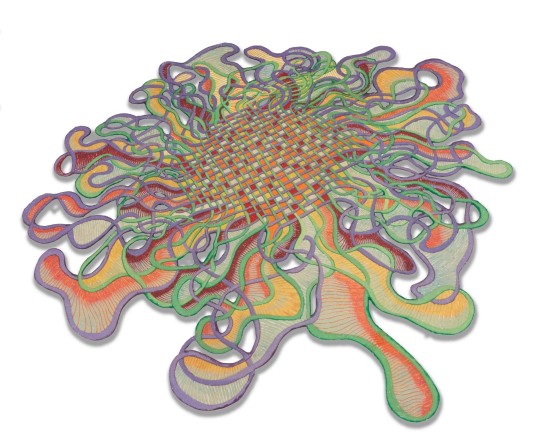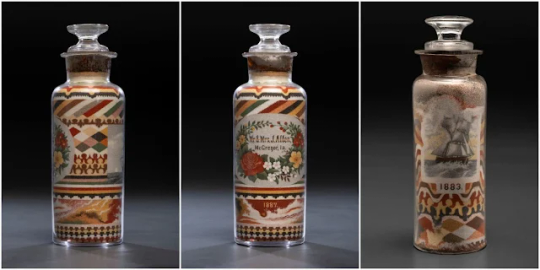#Sand Painting
Explore tagged Tumblr posts
Text

Joe Mangrum — Grid Subversion (colored sand & acrylic on shaped wood panel, 2017)
250 notes
·
View notes
Text

This article looks at the meaning of Aboriginal art from North Central Australia. Central Australia is where aboriginal dot art originated. Comprehending aboriginal art meaning is not easy. It may take some time to get your mind around it. It is worth the effort.
#art#aboriginal art#aboriginal painting#australian art#aboriginal artist#australia#painting#aboriginal culture#sand painting
334 notes
·
View notes
Text

© Peter Arkle 2024 NAVAJO SAND PAINTING DEMONSTRATION AT MOMA (that's Jackson Pollock watching and being inspired over on the middle left)
9 notes
·
View notes
Text
Read and study
Me
Like a mandala
Painted with sand
Only to be
Blown
Away on a
Breeze
#my writing#poetry#poem#mandala#tibetan buddhism#spilled ink#creative writing#poets on tumblr#writers on tumblr#writers and poets#quick write#permanent impermanence#sand painting
19 notes
·
View notes
Text

Navajo Sand Painting Art by Native American Artist Larry Antonio Authentic || SWtradepost
28 notes
·
View notes
Text
Halloween Sand Art by "Anna"
(My old Sand Sculpture site.)
#sand art#sand#art#caroline leaf#Andrew Clemens#sand bottle#sand castle#sand play#sand painting#sand festival#sand angels#sand animation#Co Hoedeman#Ferenc Cakó#Kseniya Simonova#Ilana Yahav#halloween#happy halloween#spooky#halloween art#spooky art
3 notes
·
View notes
Text


Following the establishment of the Take Anda Museum in the late 1970's, Museum Director, Akii Timu was looking for an activity to be centred there, that could bring out the creativity of Enga's people and provide an opportunity to make and income particularly for school leavers.
With the challenge of finding a cheap and readily available medium to use, he turned to the colours of the Earth and began experimentin to create Enga's first sand paintings.
Soon he was able to attract interested young men who became his first apprentices and a new contemporary artform was born.




2 notes
·
View notes
Text

Started sand painting I think it turned out pretty good for my second time
#painting#sand painting#beachvibes#beachlover#beachlife#beachstyle#ocean#ocean painting#beach painting#ocean art#beach art
7 notes
·
View notes
Text
Finally finished my experimental animation test. its stop motion sand animation on a light board with handdrawn on tvpaint and a lot of editing.
9 notes
·
View notes
Text
🥺🥺🥺
#noah ebalon#elsword#sand painting#i think? i dont know how it’s called in english#elsword noah#elsword game
5 notes
·
View notes
Text
Sand art bottle
4 notes
·
View notes
Text

Style
I found a new favorite art style is actually sand painting with acrylic paint. I am still able to paint because I go to an art studio every Saturday. so I am still able to paint on daily basis. in school, we had our first project. I was not able to understand how to make a proper process journal so I am going to make one with a personal project I wanted to start for a long time. I might start today or next week.
4 notes
·
View notes
Text


How I work with glitter.
Sand Painting, Better Homes & Gardens, January 1972
0 notes
Text


Chau Nguyen, “Bài Học Về Phong Cảnh / Landscape Didactics”, 2022, sand painting

Zalika Azim, “Blood Memories (or a going to ground)”, 2023, video


Azza El Siddique, “Vessels”, 2019, ceramic, rust







Suneil Sanzgiri, “Two Refusals (Would We Recognize Ourselves Unbroken)”, 2023, video
Currently on view at The Delaware Contemporary is we are what we lose, an exhibition featuring artists Zalika Azim, Suneil Sanzgiri, Azza El Siddique, and Chau Nguyen. Through sculpture, dance, video and photography, these artists investigate issues of loss through what gets left behind.
From the museum-
“The real phenomenon of loss is both the inventory of what no longer exists and the impossible measure of what survives.” —Canisia Lubrin
What does the fugitive offer to sites of ruins? Is it a hum, a murmur, a cry, a shadow, a haunting, a poem, a memory, a scene, a loved one, a vessel, a movement, a gathering?
Fugitivity routes and unroutes our understanding of topographic terrains created through the unfolding of displacement, relocation, and exile. In the wake of migratory catastrophes, ruins are the aftermath of loss and devastation, leaving behind vestigial remnants and residuals. Reaching for traces, illegibility, and livability, the fugitive attempts to depict and texture multiple lifeworlds within ruins marked in loss and devastation. Gesturing towards the specter, how might placing what happens within sites of ruins —the permeable, usable, corporeal, and inhabitable—at the heart of our critiques and interventions enliven our imaginative possibilities?
Ruins present a set of spatial, material, visual, and psychic dimensions of un/being and becoming, as well as modes of fugitive resistance and expression. Tending to the juxtaposition of being unplaced, we are what we lose focuses on the provoking void that ruins leave behind and expresses spatial, narrative, and material practices actively and painstakingly situated in the hold of the catastrophes as means of reworlding and unworlding towards livable possibilities.
Partaking in worlding decomposition, Zalika Azim, Suneil Sanzgiri, Azza El Siddique, and Chau Nguyen present visual, narrative, and sonic performances that desire and action towards the otherly present meaning and aliveness by uncomposing time and working with the permeability of the artistic mediums. By engaging with the barely perceptible imaginations, unplaced yearnings, and tactile and vulnerable terrains, the artists orient toward spectral terrains that suture, resist, and refuse the knowability of the fugitive. Viewers will reflect on the histories of ruins haunting our contemporary sites and their capacity to mutate to make complicated ways of knowing, feeling, and seeing the world.
More information on Suneil Sanzgiri’s video installation, pictured above, from his website–
How do we live through and narrate moments of revolution and revolt, and how do we understand these experiences across time and distance? Using imaging technologies to meditate on what it means to witness from afar, Suneil Sanzgiri explores the complexities of anti-colonialism, nationalism, and diasporic identity. His work is inspired by his family’s legacy of resistance in Goa, India, an area under Portuguese occupation for over 450 years until its independence in 1961. Two Refusals (Would We Recognize Ourselves Unbroken?), the artist’s newest two-channel video installation, combines archival footage, animation, interviews, and a script written by poet Sham-e-Ali Nayeem. The film tells the stories of the mutual struggle in India and Africa against Portuguese colonialism, highlighting the solidarity that developed between the two continents during the 1960s and 1970s.
This exhibition closes 12/29/24.
#The Delaware Contemporary#Suneil Sanzgiri#Chau Nguyen#Azza El Siddique#Art#Zalika Azim#Art Shows#Dance#Delaware Art Shows#Film#Film and Video#Loss#Mixed Media Art#Photography#Ruins#Sand Painting#Sculpture#Wilmington Art Show#Ceramic Art
0 notes
Text
Exploring the Creative World of Children's Sand Painting Table Toys
Introduction to Sand Painting Sand painting is an engaging artistic activity that allows children to express their creativity in unique and immersive ways. This art form consists of applying colored sand onto surfaces, usually in intricate patterns or designs. It offers a multi-sensory experience that stimulates a child’s sense of touch, sight, and even sound, as the grains of sand create…
0 notes
Text



Sand bottle art by Andrew Clemens, 1880s
#sand art#sand bottle art#andrew clements#art history#art#colored sand#smithsonian#sand painting#commission art#sand sculpture#19 century#sand castle#sandy#sand festival#sand angles#sand mandala#process art#sand animation#yantra#bonkei#Kolam#rangoli#marmotinto
5 notes
·
View notes